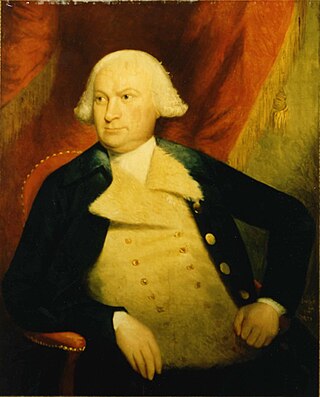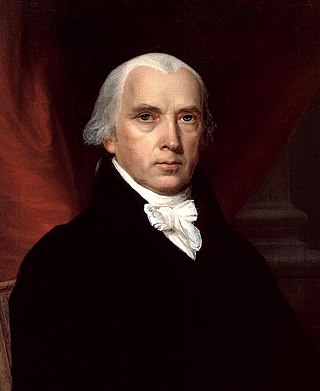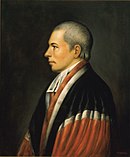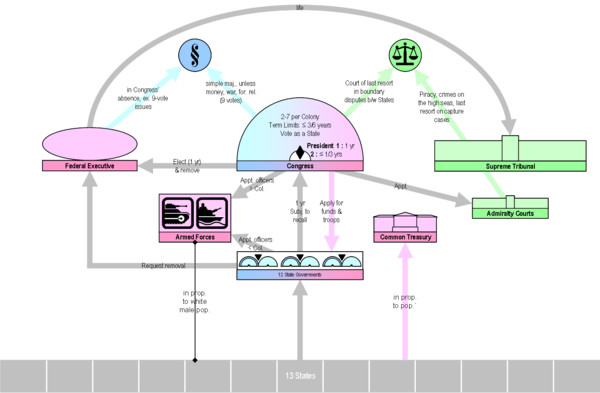
The Constitution of the United States is the supreme law of the United States. It superseded the Articles of Confederation, the nation's first constitution, on March 4, 1789. Originally including seven articles, the Constitution delineates the national frame and constrains the powers of the federal government. The Constitution's first three articles embody the doctrine of the separation of powers, in which the federal government is divided into three branches: the legislative, consisting of the bicameral Congress ; the executive, consisting of the president and subordinate officers ; and the judicial, consisting of the Supreme Court and other federal courts. Article IV, Article V, and Article VI embody concepts of federalism, describing the rights and responsibilities of state governments, the states in relationship to the federal government, and the shared process of constitutional amendment. Article VII establishes the procedure subsequently used by the 13 states to ratify it. The Constitution of the United States is the oldest and longest-standing written and codified national constitution in force in the world.

Roger Sherman was an early American statesman, lawyer, and a Founding Father of the United States. He is the only person to sign all four great state papers of the United States: the Continental Association, the Declaration of Independence, the Articles of Confederation, and the Constitution. He also signed the 1774 Petition to the King.

The Virginia Plan was a proposed plan of government for the United States presented at the Constitutional Convention of 1787. The plan called for the creation of a supreme national government with three branches and a bicameral legislature. The plan was drafted by James Madison and Edmund Randolph.
The Annapolis Convention, formally titled as a Meeting of Commissioners to Remedy Defects of the Federal Government, was a national political convention held September 11–14, 1786 at Mann's Tavern in Annapolis, Maryland, in which twelve delegates from five U.S. states gathered to discuss and develop a consensus on reversing the protectionist trade barriers that each state had erected. At the time, under the Articles of Confederation, each state was largely independent from the others, and the national government had no authority to regulate trade between and among the states. New Hampshire, Massachusetts, Rhode Island, and North Carolina had appointed commissioners, who failed to arrive in Annapolis in time to attend the meeting, and Connecticut, Maryland, South Carolina, and Georgia had taken no action at all. The convention also related to George Washington's plans concerning the waterways connecting the Potomac and the Ohio River.
The Three-fifths Compromise was an agreement reached during the 1787 United States Constitutional Convention over the inclusion of slaves in a state's total population. This count would determine: the number of seats in the House of Representatives; the number of electoral votes each state would be allocated; and how much money the states would pay in taxes. Slave holding states wanted their entire population to be counted to determine the number of Representatives those states could elect and send to Congress. Free states wanted to exclude the counting of slave populations in slave states, since those slaves had no voting rights. A compromise was struck to resolve this impasse. The compromise counted three-fifths of each state's slave population toward that state's total population for the purpose of apportioning the House of Representatives, effectively giving the Southern states more power in the House relative to the Northern states. It also gave slaveholders similarly enlarged powers in Southern legislatures; this was an issue in the secession of West Virginia from Virginia in 1863. Free blacks and indentured servants were not subject to the compromise, and each was counted as one full person for representation.

The Connecticut Compromise was an agreement reached during the Constitutional Convention of 1787 that in part defined the legislative structure and representation each state would have under the United States Constitution. It retained the bicameral legislature as proposed by Roger Sherman, along with proportional representation of the states in the lower house or House of Representatives, and it required the upper house or Senate to be weighted equally among the states; each state would have two representatives in the Senate.

The United States Constitution has served as the supreme law of the United States since taking effect in 1789. The document was written at the 1787 Philadelphia Convention and was ratified through a series of state conventions held in 1787 and 1788. Since 1789, the Constitution has been amended twenty-seven times; particularly important amendments include the ten amendments of the United States Bill of Rights and the three Reconstruction Amendments.

The Founding Fathers of the United States, commonly referred to simply as the Founding Fathers, were a group of late-18th-century American revolutionary leaders who united the Thirteen Colonies, oversaw the War of Independence from Great Britain, established the United States, and crafted a framework of government for the new nation.

Luther Martin was a Founding Father of the United States, framer of the U.S. Constitution, politician, lawyer, and slave owner. Martin was a delegate from Maryland to the Constitutional Convention in 1787, but did not sign the Constitution, having left the convention early because he felt the document as proposed violated states' rights. In the months following the convention, he was a leading Anti-Federalist, along with Patrick Henry and George Mason, whose collective efforts led to the passage of the Bill of Rights.

The Constitutional Convention took place in Philadelphia from May 25 to September 17, 1787. Although the convention was intended to revise the league of states and first system of government under the Articles of Confederation, the intention from the outset of many of its proponents, chief among them James Madison of Virginia and Alexander Hamilton of New York, was to create a new Frame of Government rather than fix the existing one. The delegates elected George Washington of Virginia, former commanding general of the Continental Army in the late American Revolutionary War (1775–1783) and proponent of a stronger national government, to become President of the convention. The result of the convention was the creation of the Constitution of the United States, placing the Convention among the most significant events in American history.
A convention to propose amendments to the United States Constitution, also referred to as an Article V Convention, state convention, or amendatory convention is one of two methods authorized by Article Five of the United States Constitution whereby amendments to the United States Constitution may be proposed: two thirds of the State legislatures may call a convention to propose amendments, which become law only after ratification by three-fourths of the states. The Article V convention method has never been used; but 33 amendments have been proposed by the other method, a two-thirds vote in both houses of Congress; and 27 of these have been ratified by three-fourths of the States. Although there has never been a federal constitutional convention since the original one, at the state level more than 230 constitutional conventions have assembled in the United States.

The Virginia Ratifying Convention was a convention of 168 delegates from Virginia who met in 1788 to ratify or reject the United States Constitution, which had been drafted at the Philadelphia Convention the previous year.

The drafting of the Constitution of the United States began on May 25, 1787, when the Constitutional Convention met for the first time with a quorum at the Pennsylvania State House in Philadelphia, Pennsylvania to revise the Articles of Confederation. It ended on September 17, 1787, the day the Frame of Government drafted by the convention's delegates to replace the Articles was adopted and signed. The ratification process for the Constitution began that day, and ended when the final state, Rhode Island, ratified it on May 29, 1790.

The Congressional Apportionment Amendment is a proposed amendment to the United States Constitution that addresses the number of seats in the House of Representatives. It was proposed by Congress on September 25, 1789, but was never ratified by the requisite number of state legislatures. As Congress did not set a time limit for its ratification, the Congressional Apportionment Amendment is still pending before the states. As of 2024, it is one of six unratified amendments.
The Fugitive Slave Clause in the United States Constitution, also known as either the Slave Clause or the Fugitives From Labor Clause, is Article IV, Section 2, Clause 3, which requires a "Person held to Service or Labour" who flees to another state to be returned to his or her master in the state from which that person escaped. The enactment of the Thirteenth Amendment to the United States Constitution, which abolished slavery except as a punishment for criminal acts, has made the clause mostly irrelevant.

The Confederation period was the era of United States history in the 1780s after the American Revolution and prior to the ratification of the United States Constitution. In 1781, the United States ratified the Articles of Confederation and Perpetual Union and prevailed in the Battle of Yorktown, the last major land battle between British and American Continental forces in the American Revolutionary War. American independence was confirmed with the 1783 signing of the Treaty of Paris. The fledgling United States faced several challenges, many of which stemmed from the lack of a strong national government and unified political culture. The period ended in 1789 following the ratification of the United States Constitution, which established a new, more powerful, national government.
The Committee of Detail was a committee established by the United States Constitutional Convention on July 24, 1787 to put down a draft text reflecting the agreements made by the convention up to that point, including the Virginia Plan's 15 resolutions. The convention adjourned from July 26 to August 6 to await their report. Much of what was contained in the final document was present in this draft.

Oliver Ellsworth was a Founding Father of the United States, attorney, jurist, politician, and diplomat. Ellsworth was a framer of the United States Constitution, United States senator from Connecticut, and the third chief justice of the United States. Additionally, he received 11 electoral votes in the 1796 presidential election.

The Signing of the United States Constitution occurred on September 17, 1787, at Independence Hall in Philadelphia, Pennsylvania, when 39 delegates to the Constitutional Convention, representing 12 states, endorsed the Constitution created during the four-month-long convention. In addition to signatures, this endorsement, the Constitution's closing protocol, included a brief declaration that the delegates' work has been successfully completed and that those whose signatures appear on it subscribe to the final document. Included are, a statement pronouncing the document's adoption by the states present, a formulaic dating of its adoption, along with the signatures of those endorsing it. Additionally, the convention's secretary, William Jackson, added a note to verify four amendments made by hand to the final document, and signed the note to authenticate its validity.

James Madison was an American statesman, diplomat, and Founding Father who served as the 4th president of the United States from 1809 to 1817. He is hailed as the "Father of the Constitution" for his pivotal role in drafting and promoting the Constitution of the United States and the Bill of Rights. Disillusioned by the weak national government established by the Articles of Confederation, he helped organize the Constitutional Convention, which produced a new constitution. Madison's Virginia Plan served as the basis for the Constitutional Convention's deliberations, and he was one of the most influential individuals at the convention. He became one of the leaders in the movement to ratify the Constitution, and he joined with Alexander Hamilton and John Jay in writing The Federalist Papers, a series of pro-ratification essays that was one of the most influential works of political science in American history.











